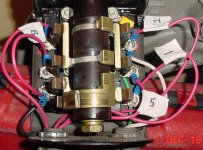Nitromahn
Aluminum
- Joined
- Sep 11, 2008
- Location
- Bethel, Alaska USA
Ok, I had an electrician over here for five hours gratis, he left extremely frustrated. He could only get the motor to run in the forward direction, anything else would pop the breakers. I gave him all the diagrams I had copied from the searches here, and others elsewhere. He swears both the motor and switch were wired correctly. He finally wired the motor to run, but only in the forward direction. He thinks it has to be "something unseen". Meaning the switch could be bad or even the motor. BUT it is a factory new motor soo......
The first pic is the motor as wired to run in the forward position. The only wires connected from the switch are 1 and 2 and you can see the labels at the top and bottom. The two pink wires heading off to the right out of the photo are 5 and 8, both capped off until we (Mr. Sparky and me), get an answer.
The second pic is the switch in the off position. Cast copper conductors in this 1926 Westinghouse!
The dark green (or black), wire comes in and runs off to the left to connect at the bottom of the bank of posts.
The light green runs up the right side to the top;you can see the yellow connector.
You can see where the white goes.
Third pic is the forward position.
Fourth pic is (drum-roll), the reverse position.
Ok boys and girls: tell me what goes where, and do it sssllloooowwwllllyyyy, please. You are dealing with a chemist, not a fellow machinist or sparkician.
This is a 3/4 h.p., 1125rpm, 110v single-phase, split-phase capacitor start, AC motor. It has one hump on the top. Baldor Model CHC3528A.
Good idea Gary.
Quyana.
The first pic is the motor as wired to run in the forward position. The only wires connected from the switch are 1 and 2 and you can see the labels at the top and bottom. The two pink wires heading off to the right out of the photo are 5 and 8, both capped off until we (Mr. Sparky and me), get an answer.
The second pic is the switch in the off position. Cast copper conductors in this 1926 Westinghouse!
The dark green (or black), wire comes in and runs off to the left to connect at the bottom of the bank of posts.
The light green runs up the right side to the top;you can see the yellow connector.
You can see where the white goes.
Third pic is the forward position.
Fourth pic is (drum-roll), the reverse position.
Ok boys and girls: tell me what goes where, and do it sssllloooowwwllllyyyy, please. You are dealing with a chemist, not a fellow machinist or sparkician.
This is a 3/4 h.p., 1125rpm, 110v single-phase, split-phase capacitor start, AC motor. It has one hump on the top. Baldor Model CHC3528A.
Good idea Gary.
Quyana.











 After awhile you start seeing wires in your sleep.
After awhile you start seeing wires in your sleep.


